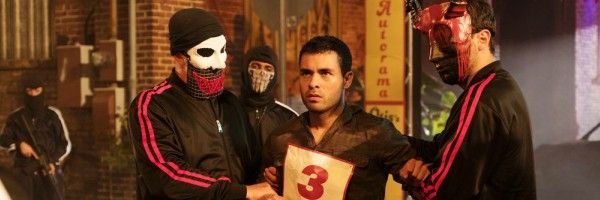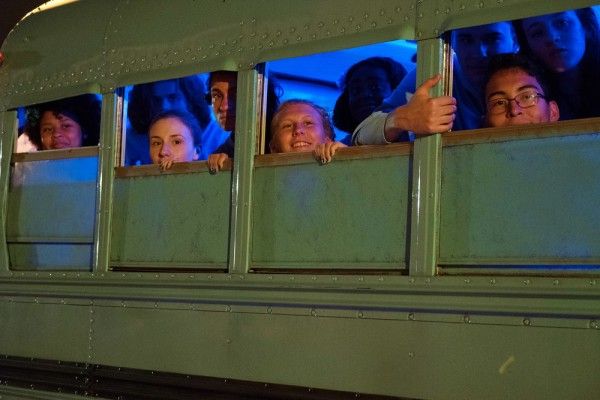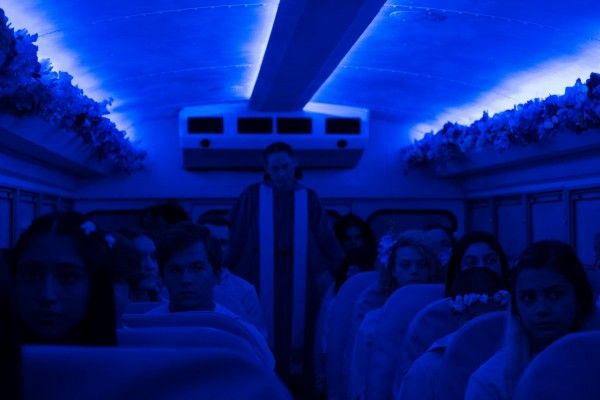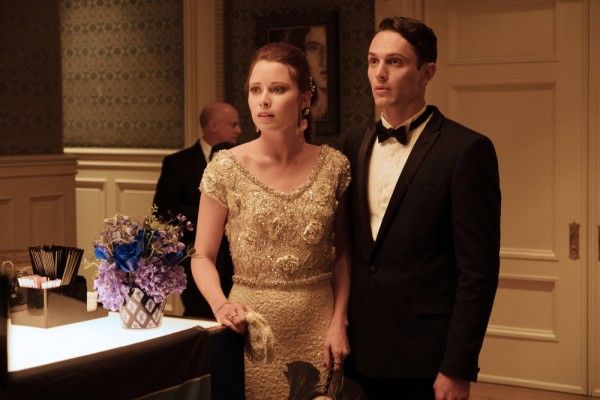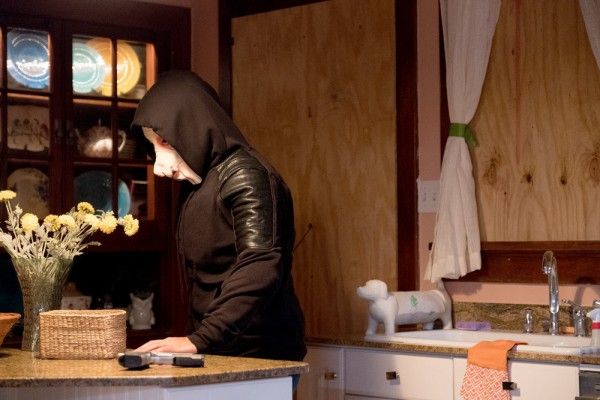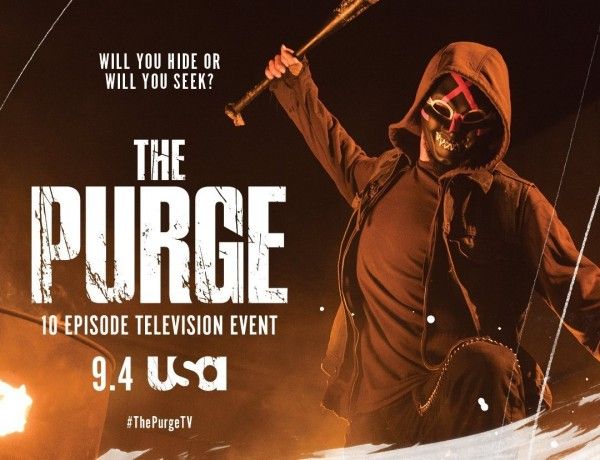It all started with a $3 million budget and a killer idea. The Purge. Created by James DeMonaco and backed by Blumhouse, the horror thriller introduced audiences to a not-too-distant future America where all crime, including murder, becomes legal for 12 hours a year. Four films and more than $400 million at the box office later, The Purge has travelled from suburbia to the streets of Downtown Los Angeles, and ultimately, back to the very first Purge night in Staten Island, unfolding an expansive mythology and undercurrent of pointed political commentary along the way.
Now, The Purge is headed to television with USA Network's 10-hour event series, which offers fans the deepest look into the world of the Purge yet. With more time and real estate than ever, the series looks to travel through the experience of different class structures and human experiences on the night of the Purge, stretched out across a 10-hour canvas that allows for a diverse ensemble of characters and a whole lot of, well... Purging.
Back in June, I had the opportunity to join al group of journalists on the set of The Purge in New Orleans, Louisiana, where production was underway on the fifth episode of the first season. We toured the sets, spoke with the cast and crew, and observed filming, and everything I saw there got me very interested and invested in how the creative team is approaching this all too relevant horror story.
Some of the most impressive details of what we saw are still under embargo, including an immersive set that was easily one of the most spectacular (and sickening) constructions I've ever seen on a working set. But even with that reveal still to come, we learned a lot during our hours on set, so I've broken down the biggest need-to-know details below.
The Purge will premiere will premiere Tuesday, September 4 at 10/9c on USA Network.
The Story
- Showrunner Thomas Kelly is new to the horror genre, best known as a producer and novelist of crime dramas. He was excited by the idea of working on The Purge because it’s a horror franchise that has something to say. “In the first moviem in the first ten minutes ... alright it's the Purge but it's a black guy being chased down the street by a white mob. So, right away to me that says, ‘Alright, he's doing something more, he isn't just doing like a horror show,’ which was not always my thing."
- The series will continue the franchise tradition of confronting real world themes and cultural allegory, serving as a “cautionary tale” about political divisiveness, but everyone on the creative team wants to ensure that it’s a story that reaches across political parties and appeals to a wide audience. “I don't want to do a show where if you like Fox News, you're going to watch our show; if you like MSNBC, you can't watch our show... We have a lot more in common than people seem to recognize sometimes," Kelly explained. “We could have done a version where it's more identifiably to the left, you know. To me it doesn't matter. There's dictators on the left and dictators on the right. But for us it's the idea of too few people are empowered to make decisions, and they're driving forces like doing what's best for them and not what's best for the greater democratic good.”
- Emmy-winning American Crime Story and Unsolved director Anthony Hemingway was recruited to direct the pilot. “I don't use this word lightly because I worked on a show where they described the guy as a visionary and it was kind of a clown show, but he literally is a visionary,” said Kelly, praising the filmmaker’s ability to always go bigger and bolder with each scene without being bogged down by time or budget constraints. “Thank god he was here to flesh out the team and help us make decisions,” Kelly added.
- Kelly made an effort to assemble a diverse writers’ room. Not just in terms of race and gender, but also class in order to do the diverse characters surviving the Purge justice. "They were able to share experiences which definitely informed [the characters],” the showrunner explained. “We really tried form those different points of views and sensibilities into the characters we were creating. I think our main cast speaks for itself, it's pretty diverse. In our story, it’s very different lives and experiences, and the commonality of how they act under duress.”
- The series is primarily set on Purge night, over the course of 12 hours, and each episode will focus on the Purge.
- The writers are also using the freedom of a 10-hour episode structure to employ flashbacks that expand on their characters and explore what post-Purge America looks like on the other 364 days a year. “It’s definitely more character-driven,” Kelly said, comparing the series to the films. "It's more, at times, a straight drama, where it's really doing it in a way where we see these people, particularly in flashbacks, average Americans going through different things in their lives and having to deal with it.”
- Season 2 isn’t confirmed and nothing is set in stone at this point, but the original idea is that The Purge will function as an anthology series and any subsequent seasons would travel to different cities, focusing on different characters.
- Though filmed in New Orleans, the series isn't meant to evoke any specific location. Instead, it's designed to take on an "Everytown" feel that all viewers can relate to.
The Characters
- Colin Woodell and Hannah Anderson play Rick and Jenna Bettencourt, an anti-Purge married couple who are going out on Purge night for the first time ever in the hopes of landing funding at the big high society event hosted by the Stanton family.
- Anderson describes Jenna as a purist and an innocent, who’s terrified by their journey that night. Woodell says Rick is terrified too and has a moral compass, but is a “little more realistic in terms of this being the first and maybe finite opportunity for both of them.”
- Jenna is also pregnant, a fact that's pulling them together in this time of crisis. "We're a family now, so we're thinking about it in a different way," Anderson said. "We're protecting a family, is a very different thing than just having the two of you."
- Lili Simmons plays Lila Stanton, socialite and daughter of elite Purge supporters. Her arc ties into the Bettencourts in a story Kelly says will “get a lot more into issues of marriage, relationships, and class.” Though Lila’s parents are some of the most prominent Purge participants and supporters, Lila is anti-Purge and dedicated to her charity work, but she knows the best way to get her work done is to “keep them on [her] good side and keep the money flowing,” Simmons explained.
- While Lila and the Bettencourts introduce us to Purge night among the wealthy elites, other characters will take us into the chaos on the streets. Gabriel Chavarria plays Miguel, who the actor describes as “A marine that’s got a bit of a hard edge to him but he’s on a noble mission.” After he receives a cryptic letter from his sister Penelope (Jessica Garza), he comes back to town in the middle of the Purge insanity to find her.
- Miguel is also one of the first people we see kill, and he does it before the Purge actually begins. So he’s not anti-killing, but Chevarria says the character is definitely anti-Purge. “He’s totally against it. He’s not for it at all,” the actor said.
- Miguel’s sister Penelope is a member of the cult lead by Fiona Dourif’s Good Leader Tavis, who believe it is their duty to serve as Martyrs for those who wish to Purge. Penelope starts out a believer, but quickly questions her choices when she sees one of her fellow devotees brutally Purged.
- In keeping with the mythology of blue flowers (which are left outside to represent support of the annual Purge), the cult members are dressed in powder blue outfits and ride around in a matching bus.
- Somewhere between the criminal underworld and the Stanton mansion, we also catch up with the working class folks trying to make their American Dream come true on Purge night. Amanda Warren plays Jane, who the actress describes as “a very driven, very determined white collar professional in the finance world who has apparently reached some insurmountable glass ceiling in the workplace.” After hitting the ceiling one too many times, she takes matters into her own hands on Purge night and hires an assassin.
- Kelly thinks Jane is probably the most relatable character to the audience. “She's done everything right, she's smart, she's hard-working. She works in finance, but she's been thwarted in her advancement because of gender and race, and it's often quite subtle. It shows in flashback what goes on.” But even though Jane makes the decision to embrace the Purge based on “legitimate grievances,” Kelly says it’s a decision she comes to regret quickly because she’s a “morally-centered person.”
- We also get a sympathetic look at a supporter of the NFFA, aka the New Founding Fathers who established the Purge (as detailed in The First Purge) through the character of Joe (Lee Tergesen). Kelly describes Joe as a “fairly likable” guy who got burned by de-industrialization and economic shifts. Like Jane, he did everything right and got screwed for it, so he becomes “a sort of victim of the very cynical salesmen of the NFFA,” who convince him that Purging is his right and he’s doing the right thing. “There's some sort of tragedy in Joe,” Kelly said, “as the guy who really did everything right and didn't deserve what he got, and yet because of a toxic political climate, he's allowed to sort of express and deal with his frustrations in a way that, to us, is morbid, but for someone who's been brought up that way, in that system, in the world of the Purge… he thinks that he's doing the right thing.”
The Design
- Costume designer Lauren Bott says the series will have plenty of Purge iconography -- she and her team are designing anywhere between 10-15 new masks per episode.
- We saw a number of impressive costumes and masks on display, including a creepy creation with fishnets and jewelry, a monstrous doctor, and a whole bunch of black-and-white serial killer cutout masks, which will be worn at the elite Purge party hosted by Lila’s parents, the Stantons.
- Bott’s favorite costumes were the bloody nuns, a group of LED-lit nuns with black blood running down from their eyes and jacked-up dentures sewn in at the mouth. Chavarria, who played a scene with the nuns in full action agreed. “The bloody nuns, were by far probably the coolest thing visually I’ve ever experienced on a set,” he said. “There was no acting involved, that was being in the moment.”
- For Bott, the keys to designing a Purge mask are A) it has to have a DIY feel and B) it needs to mix “a human element with some level of disgust… if you lose the human element completely, you lose the scare tactic."
- The show introduces a safe zone, where people can escape from the brutality of Purge night… in a bar. If the Purge were real, you’d probably find me in Pete’s Cantina, the local establishment in the series where anyone can go hangout, hang up their mask and weaponry, and enjoy a drink without being kill. The Cantina is run by a cop and intended to give people a place to “stop and think about doing the act,” set designer Sharon Lomofsky explained.
- Though the series is set years into the future (2027, specifically), it’s very intentionally designed to look the same as today. “We make no concessions to anything futuristic,” Kelly said. “So it feels very of the moment. That's very purposeful. We don't want to take people out and give them the sort of comfort of, 'Oh, it's ten years from now, this could never happen.’”

